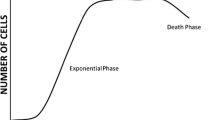Summary
The growth of human glioma cells, cultured as spherical colonies in agarose gel, stopped after about 10 days for both large and small colonies apparently due to an increased osmolality in the gel. When osmolality was kept under control by addition of distilled water, growth continued. However, a continuous increase in the population-doubling period, similar for both large and small colonies, then was observed. The increase persisted although excess amounts of nutrition were added. When the cells were cultured in liquid suspension above a thin layer of agarose gel and most of the medium was repeatedly changed, the colonies continued to grow beyond the limits in gel culture. HeLa and hamster embryonic lung cell colonies showed a growth pattern in agarose gel similar to the glioma cells. The results imply that the osmolality must be kept under precise control to prevent growth inhibition. However, it seems difficult to ascertain optimal growth in gel culture for more than about 2 weeks probably because of the accumulation of toxic products.
Similar content being viewed by others
References
Sanders, F. K., and B. O. Burford. 1964. Ascites tumours from BHK21 cells transformed in vitro by polyoma virus. Nature 201: 786–789.
MacPherson, I., and L. Montagnier. 1964. Agar suspension culture for the selective assay of cells transformed by polyoma virus. Virology 23: 291–294.
Eagle, H., G. E. Foley, H. Koprowski, H. Lazarus, E. M. Levine, and R. A. Adams. 1970. Growth characteristics of virus transformed cells. J. Exp. Med. 131: 863–879.
Giard, D. J., S. A. Aaronson, G. J. Todaro, P. Arnstein, J. H. Kersey, H. Dosik, and W. P. Parks. 1973. In vitro cultivation of human tumours: Establishment of cell lines derived from a series of solid tumours. J. Nat. Cancer Inst. 51: 1417–1423.
McAllister, R. M., and G. Reed. 1968. Colonial growth in agar of cells derived from neoplastic and non-neoplastic tissues of children. Pediatr. Res. 2: 356–360.
Carlsson, J. 1977. A proliferation gradient in three-dimensional colonies of cultured human cells. Int. J. Cancer 20: 129–136.
Carlsson, J., and U. Brunk. 1977. Fine structure of three-dimensional colonies of human glioma cells in agarose culture. Acta Pathol. Microbiol. Scand. Sect. A 85: 183–192.
Folkman, J., M. Hochberg, and D. Knighton. 1974. Self-regulation of growth in three dimensions: The role of surface area limitation. In: B. Clarksson, and R. Baserga (Eds.),Control of Proliferation in Animal Cells, Cold Spring Harbor Laboratory, Cold Spring Harbor, N.Y., pp. 833–842.
McAllister, R., G. Reed, and R. J. Huebner. 1967. Colonial growth in agar of cells derived from adenovirus-induced hamster tumours. J. Nat. Cancer Inst. 39: 43–53.
Fox, M., and C. W. Gilbert. 1966. Continuous irradiation of a murine lymphoma line P388F in vitro. Int. J. Radiat. Biol. 11: 339–347.
Nias, A. H. W., and M. Fox. 1968. Minimum clone size for estimating normal reproductive capacity of cultured cells. Br. J. Radiol. 41: 468–474.
Bennet, M., R. S. Cudkowicz, R. S. Foster, and D. Metcalf. 1971. Hemopoietic progenitor cells of W-anemic mice studied in vivo and in vitro. J. Cell Physiol. 71: 211–226.
Dicke, K. A., M. G. C. Platenburg, and D. W. van Bekkum. 1971. Colony formation in agar: In vitro assay for haemopoietic stem cells. Cell Tissue Kinet. 4: 463–477.
MacPherson, I. 1973. Soft agar techniques. In: P. F. Kruse, and M. K. Patterson (Eds.),Tissue Culture Methods and Applications. Academic Press, London and New York, pp. 276–280.
Westermark, B., J. Pontén, and R. Hugosson. 1973. Determinants for the establishment of permanent tissue culture lines from human gliomas. Acta Pathol. Microbiol. Scand. Sect A 81: 791–805.
Crowell, R. L., B. J. Landau, and L. Philipson. 1971. The early interaction of coxsackievirus B3 with HeLa cells (35732). Proc. Soc. Exp. Biol. Med. 137: 1082–1088.
Kato, R. 1967. Localization of “spontaneous” and rous sarcoma virus-induced breakage in specific regions of the chromosomes of the Chinese hamster. Hereditas 58: 221–247.
Polson, A., and D. G. Parkyn. 1969. Determination of diffusion coefficients by spreading from thin layers. Biopolymers 7: 107–117.
Arnott, S., A. Fulmer, W. E. Scott, I. C. M. Dea, R. Moorehouse, and D. A. Rees. 1974. The agarose double helix and its function in agarose gel structure. J. Mol. Biol. 90: 269–284.
Carlsson, J., H. Lundqvist, and J. Pontén. 1976. The measurement of spatial precursor distribution in cell culture. In Vitro 12: 571–579.
Sokal, R. R., and F. J. Rohlf. 1969.Biometry: The Principles and Practice of Statistics in Biological Research. W. H. Freeman Co., San Francisco, pp. 220–223.
Westermark, B. 1973. The deficient density-dependent growth control of human malignant glioma cells and virus-transformed glia-like cells in culture. Int. J. Cancer 12: 438–451.
Eagle, H. 1974. Some effects on environmental pH on cellular metabolism and function. In: B. Clarkson, and R. Baserga (Eds.),Control of Proliferation in Animal Cells, Cold Spring Harbor Laboratory, Cold Spring Harbor, N.Y., pp. 1–11.
Carlsson, J., and M. Malmqvist. 1977. Effects of bacterial agarase on agarose gel in cell culture. In Vitro 13: 417–422.
Waymouth, C. 1973. Determination and survey of osmolality in culture media. In: P. F. Kruse, and M. K. Patterson (Eds.),Tissue Culture Methods and Applications. Academic Press, London and New York, pp. 703–708.
Pirt, S. J., and E. J. Thackeray. 1964. Environmental influences on the growth of ERK-mamalian cells in monolayer culture. Exp. Cell Res. 33: 396–405.
Rubin, H. 1971. Growth regulation in cultures of chick embryo fibroblasts. In: G. E. Wolstenholme, and J. Knight (Eds.),Growth Control in Cell Cultures. Churchill-Livingstone, London, pp. 127–144.
Stoker, M., C. O'Neill, S. Berryman, and V. Waxman. 1968. Anchorage and growth regulation in normal and virus-transformed cells. Int. J. Cancer 3: 683–693.
Author information
Authors and Affiliations
Additional information
The work was supported financially by the Swedish Cancer Society and the Swedish Natural Science Research Council.
Rights and permissions
About this article
Cite this article
Carlsson, J. Physical and nutritional factors in gel culture of mammalian cells. In Vitro 14, 860–867 (1978). https://doi.org/10.1007/BF02616156
Issue Date:
DOI: https://doi.org/10.1007/BF02616156




